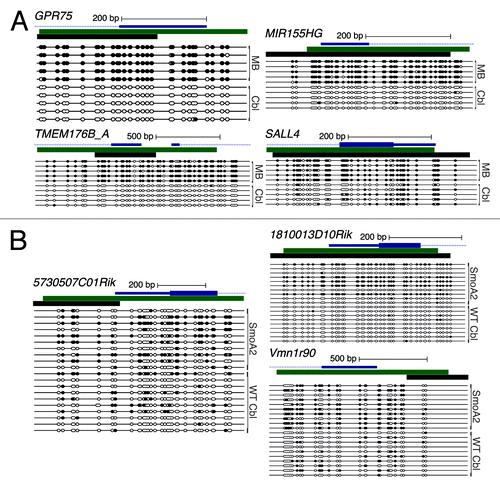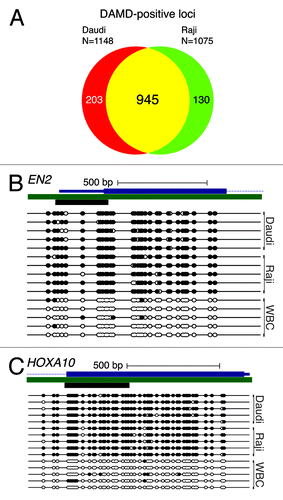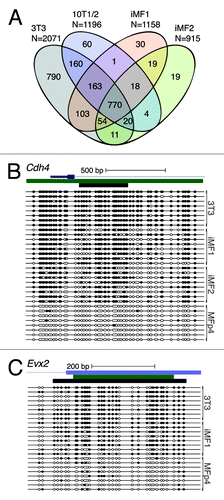Figures & data
Table 1. DNA methylation of promoter CpG islands in human and mouse medulloblastoma
Figure 1. Bisulfite sequence analysis of loci identified by Reduced Representation Bisulfite Sequencing from human and SmoA2 medulloblastoma. (A) Bisulfite sequence analysis of GPR75, MIR155HG, TMEM176B_A, and SALL4 from human medulloblastoma (MB) and normal cerebellum (Cbl). The black rectangle shows the genomic region subjected to bisulfite sequence analysis; the mRNA structure (exon, large rectangle; intron, thin line; untranslated region (UTR), small rectangle; arrow, direction of transcription) is shown in blue; any associated CpG island is shown using a green rectangle. Solid circles represent CpG methylation, and open circles depict unmodified CpG dinucleotides. (B) Bisulfite sequence analysis of 5730507C01Rik, 1810013D10Rik, and Vmn1r90 from SmoA2 and wild-type cerebellum (WT Cbl).

Figure 2. Human Burkitt lymphoma cell lines demonstrate extensive promoter CpG island DNA hypermethylation. (A) DAMD-positive loci from the human Burkitt lymphoma cell lines Daudi and Raji are depicted, and common loci are indicated with a Venn diagram. (B and C) Bisulfite sequence analysis of engrailed homeobox 2 (EN2) and homeobox A10 (HOXA10) from Daudi, Raji, and peripheral white blood cells (WBC). See legend for labeling schematic.

Figure 3. Mouse fibroblast cells obtain global promoter CpG island DNA hypermethylation during the process of spontaneous immortalization. (A) DAMD-positive loci from the established mouse fibroblast cell lines 3T3 and 10T1/2, and two independent newly immortalized mouse fibroblast cell lines (iMF1 and iMF2), are depicted. Common loci are indicated on a Venn diagram. (B and C) Bisulfite sequence analysis of Cdh4 and Evx2 from 3T3, iMF1, iMF2, and an early passage primary mouse fibroblast culture (MFp4). See legend for labeling schematic.
